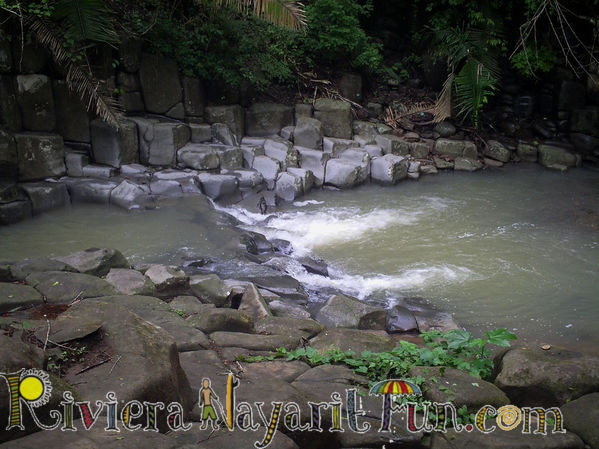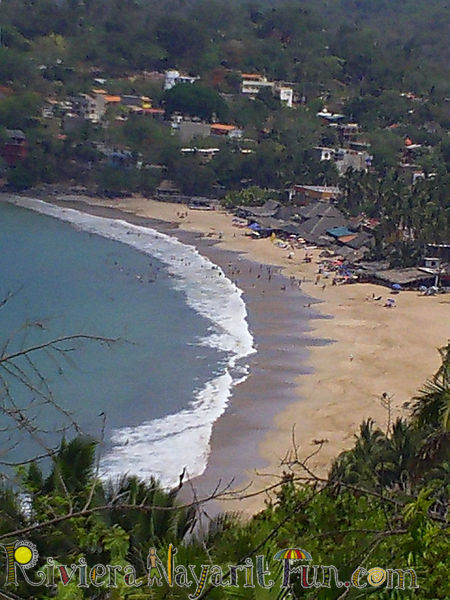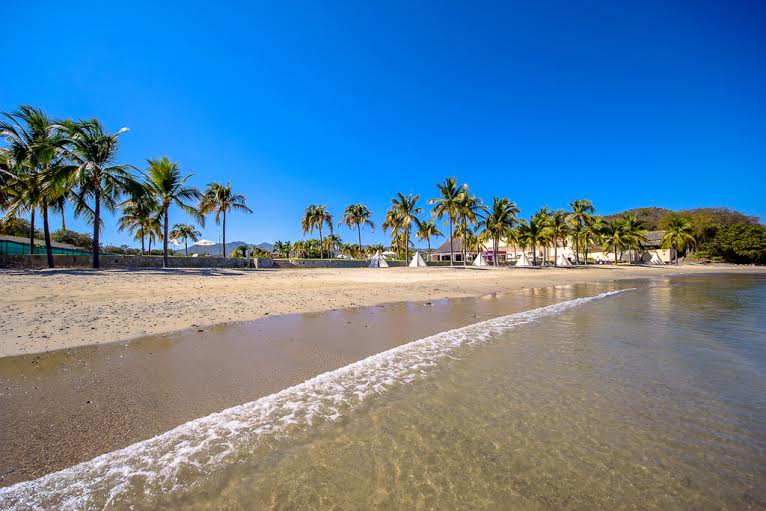The Art of Surfing in Sayulita, La Caleta, Chacala and on the Riviera Nayarit in beautiful Mexico
Ahhhhhhhh. Perfect condtions!! Early morning, clear skies, surf cracking on the beach, creating the desired barrel shape – this is what we wait for! Time to grab the board and wax ! A couple of great
– this is what we wait for! Time to grab the board and wax ! A couple of great places to learn how to surf are Chacala and Sayulita Mexico. Why not get away to the Riviera Nayarit for some surfing on your Easter Holiday? Here is a great view of the Chacala town and beach.
places to learn how to surf are Chacala and Sayulita Mexico. Why not get away to the Riviera Nayarit for some surfing on your Easter Holiday? Here is a great view of the Chacala town and beach.
How is a Wave Created?
To understand what causes surf, we look at the swell direction, tide and wind. These factors combined in the right combo creates the desired shape for a good surf . When a wave rolling along encounters a sand bar or rocky bottom, the lower part of the wave’s energy drags against this resistance and slows down. The top part of the wave’s energy continues moving at the same speed and that is why it starts tipping forward, eventually breaking. The more dramatic the bottom profile of the reef or sandbar, the hollower the wave becomes. The direction of the surf break is also dependent on whether the area has a hard bottom or a sand bottom. Sand bottom peaks move around the beach and transfers the sand so the peak doesn’t stay the in the same location. These, however, are preferable for beginners to learn this popular sport. Lessons are usually provided for basically all ages. Surfers have progressed into the more “mature” age bracket in recent years, unlike the syndrome of years gone by, where the perception of surfers were associated with youth, hippies, budget travelers, etc. We now see surfers of all age brackets, many with very high tech and expensive boards and accessories.
tipping forward, eventually breaking. The more dramatic the bottom profile of the reef or sandbar, the hollower the wave becomes. The direction of the surf break is also dependent on whether the area has a hard bottom or a sand bottom. Sand bottom peaks move around the beach and transfers the sand so the peak doesn’t stay the in the same location. These, however, are preferable for beginners to learn this popular sport. Lessons are usually provided for basically all ages. Surfers have progressed into the more “mature” age bracket in recent years, unlike the syndrome of years gone by, where the perception of surfers were associated with youth, hippies, budget travelers, etc. We now see surfers of all age brackets, many with very high tech and expensive boards and accessories.
Lessons in Chacala
The instructions are very easy to follow, with an initial briefing, and practical moves and tips out of the water, you will then
 proceed into the ocean on the sandy bottom conditions of the main beach in Chacala, with the
proceed into the ocean on the sandy bottom conditions of the main beach in Chacala, with the  instructor at your side at all times. Check out their website here. You will slowly be taken through the maneuvers, talked through the formation of the wave that you need to look for and before you know it, your up taking the ride of your life. Riding down the face of the wave just on the sheer power of the natural ocean. The feeling is so exhilarating, and it’s no wonder this sport is becoming so ever increasingly popular and was/is the * sport of kings! *sport of kings – *(exerts from surfing handbook)
instructor at your side at all times. Check out their website here. You will slowly be taken through the maneuvers, talked through the formation of the wave that you need to look for and before you know it, your up taking the ride of your life. Riding down the face of the wave just on the sheer power of the natural ocean. The feeling is so exhilarating, and it’s no wonder this sport is becoming so ever increasingly popular and was/is the * sport of kings! *sport of kings – *(exerts from surfing handbook)Next step -LAS CALETAS!!
Las Caletas is very unique, due to it’s natural and isolated location, with jungle surrounding a slightly rocky point and bay that is most easily accessed by panga. This pleasant short ride will take about 10 minutes for a slight fee, depending on how large your group is. (price is per boat, not per person)
This is only a left break because the rocky point faces south. The waves hit the point and wrap around into the cove.
These  conditions make for a larger surf break, hence attracting more experienced surfers from Mexico and around the globe. At the Chacala Hostel and Surf Shop, include surfing lessons and boards, along with a beautiful Hostel for rental accommodations. Check out the picture of this surfer at Caleta. Here are some other pics from the 2012 Mexico Surfing Tournament as well, as well as the article with the winners!
conditions make for a larger surf break, hence attracting more experienced surfers from Mexico and around the globe. At the Chacala Hostel and Surf Shop, include surfing lessons and boards, along with a beautiful Hostel for rental accommodations. Check out the picture of this surfer at Caleta. Here are some other pics from the 2012 Mexico Surfing Tournament as well, as well as the article with the winners!
The Origins of Surfing
Tracing the origins of surfing, we know that the sport migrated from Western Polynesia to the Hawaiian Islands somewhere around 1000 A.D. But, back then, it was much more than just a sport, it was a way of life, bordering on religion. All classes surfed, but the Hawaiian kapu system of laws was in place. Chiefs were tops, and they used the sport to prove their strength, agility and royalty over the commoners. They even held contests with land as the stakes.
Even the making of surfboards was a ritual. Kahuna would search in earnest for just the right tree. Once found, they would sacrifice a fish as an offering to the gods and stand guard over the specimen overnight, praying for successful completion.
What Kind of Surfboard Do I Need?
Surfboards themselves, even further defined the social classes of kapu. There were four types, three of which were surfed upon only by the commoner: The Paipo, a short board, 2’ to 6’ in length and mostly ridden by women and children; the Alaia, 6’ to 12’, for the more agile surfer; and the Kiko’o, 12’ to 18’, for the advanced wave rider. The fourth board was the Olo. It was 15’ to 18’ and reserved for the ali’i, or ruling class.
length and mostly ridden by women and children; the Alaia, 6’ to 12’, for the more agile surfer; and the Kiko’o, 12’ to 18’, for the advanced wave rider. The fourth board was the Olo. It was 15’ to 18’ and reserved for the ali’i, or ruling class.
And the ali’i did surf.
In 1810, when Kamehameha became the Hawaiian Islands’ first king, he united the islands into one royal kingdom. Not only was Kamehameha a great warrior and diplomat, the dude was a surfer, man!
And the sport of kings was the sport of queens, as well. One of Kamehameha’s wives, Ka‘ahumanu, was a surfer, too. The couple surfed Kooka, a break located at Pua`a, in north Kona, often riding lele wa`a, or canoe leaping
In, lele wa’a, surfers jump from an outrigger canoe, with their surfboard, and then ride the wave to shore. Not an easy maneuver, lele wa’a further illustrated the ali’i’s strength and prowess over the commoners.
A half-century later, missionaries came in and not only killed off the better part of the Hawaiian population with STDs, but they also considered surfing hedonistic and banned it altogether. But another king endeared to surfing, would come along to the rescue. In 1872, upon the death of King Kamehameha V, King Kalakaua came to power and immediately reinstated the sport of surfing.
These are the roots of the sport we all love. Surfers are not bums. On the contrary, surfing is, indeed, the sport of kings. And Mexico surfing is alive and well!
Come to the Riviera Nayarit for a great surfing experience on your next Mexico vacation!














